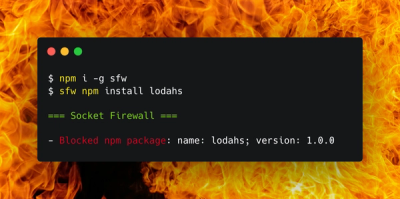
Security News
Package Maintainers Call for Improvements to GitHub’s New npm Security Plan
Maintainers back GitHub’s npm security overhaul but raise concerns about CI/CD workflows, enterprise support, and token management.
@jonkoops/matomo-tracker-react
Advanced tools
Stand alone library for using Matamo tracking in React projects
npm install @jonkoops/matomo-tracker-react
Before you're able to use this Matomo Tracker you need to create a Matomo instance with your project specific details, and wrap your application with the MatomoProvider that this package exposes.
import { MatomoProvider, createInstance } from '@jonkoops/matomo-tracker-react'
const instance = createInstance({
urlBase: 'https://LINK.TO.DOMAIN',
siteId: 3,
userId: 'UID76903202', // optional, default value: `undefined`.
trackerUrl: 'https://LINK.TO.DOMAIN/tracking.php', // optional, default value: `${urlBase}matomo.php`
srcUrl: 'https://LINK.TO.DOMAIN/tracking.js', // optional, default value: `${urlBase}matomo.js`
disabled: false, // optional, false by default. Makes all tracking calls no-ops if set to true.
heartBeat: { // optional, enabled by default
active: true, // optional, default value: true
seconds: 10 // optional, default value: `15
},
linkTracking: false, // optional, default value: true
configurations: { // optional, default value: {}
// any valid matomo configuration, all below are optional
disableCookies: true,
setSecureCookie: true,
setRequestMethod: 'POST'
}
})
ReactDOM.render(
<MatomoProvider value={instance}>
<MyApp />
</MatomoProvider>,
)
After wrapping your application with the MatomoProvider you can use the useMatomo hook to track your application from anywhere within the MatomoProvider component tree:
import React from 'react'
import { useMatomo } from '@jonkoops/matomo-tracker-react'
const MyPage = () => {
const { trackPageView, trackEvent } = useMatomo()
// Track page view
React.useEffect(() => {
trackPageView()
}, [])
const handleOnClick = () => {
// Track click on button
trackEvent({ category: 'sample-page', action: 'click-event' })
}
return (
<button type="button" onClick={handleOnClick}>
Click me
</button>
)
}
By default the Matomo Tracker will send the window's document title and location, or send your own values. Also, custom dimensions can be used:
import React from 'react'
import { useMatomo } from '@jonkoops/matomo-tracker-react'
const MyPage = () => {
const { trackPageView, trackEvent } = useMatomo()
// Track page view
React.useEffect(() => {
trackPageView({
documentTitle: 'Page title', // optional
href: 'https://LINK.TO.PAGE', // optional
customDimensions: [
{
id: 1,
value: 'loggedIn',
},
], // optional
})
}, [])
const handleOnClick = () => {
// Track click on button
trackEvent({ category: 'sample-page', action: 'click-event' })
}
return (
<button type="button" onClick={handleOnClick}>
Click me
</button>
)
}
And you can do the same for the trackEvent method:
import React from 'react'
import { useMatomo } from '@jonkoops/matomo-tracker-react'
const MyPage = () => {
const { trackEvent } = useMatomo()
const handleOnClick = () => {
// Track click on button
trackEvent({
category: 'sample-page',
action: 'click-event',
name: 'test', // optional
value: 123, // optional, numerical value
documentTitle: 'Page title', // optional
href: 'https://LINK.TO.PAGE', // optional
customDimensions: [
{
id: 1,
value: 'loggedIn',
},
], // optional
})
}
return (
<button type="button" onClick={handleOnClick}>
Click me
</button>
)
}
The useMatomo hook also exposes the following methods:
trackEvents()trackSiteSearch()trackLink()pushInstruction()For example, the pushInstruction() function can be used to push instructions to Matomo for execution. This
is equivalent to pushing entries into the _paq array.
const { pushInstruction } = useMatomo();
pushInstruction('setUserId', 'USER_ID_HERE');
Matomo provides the option to track outbound link, however, this implementation is flaky for a SPA (Single Page Application) without SSR (Server Side Rendering) across different versions of Matomo. Therefore you can use the enableLinkTracking method to listen to outbound clicks on anchor elements. This method should be placed on a component directly below your MatomoProvider on a component that's rendered on every page view. Also, make sure to disable the linkTracking option on the instance passed to the provider to prevent Matomo from catching some link clicks:
import { MatomoProvider, createInstance, useMatomo } from '@jonkoops/matomo-tracker-react'
const instance = createInstance({
urlBase: "https://LINK.TO.DOMAIN",
linkTracking: false // Important!
});
ReactDOM.render(
<MatomoProvider value={instance}>
<MyApp />
</MatomoProvider>
)
const MyApp = () => {
const { enableLinkTracking } = useMatomo()
enableLinkTracking()
return (
// Render components
)
}
FAQs
Matomo tracker for react projects
We found that @jonkoops/matomo-tracker-react demonstrated a not healthy version release cadence and project activity because the last version was released a year ago. It has 1 open source maintainer collaborating on the project.
Did you know?

Socket for GitHub automatically highlights issues in each pull request and monitors the health of all your open source dependencies. Discover the contents of your packages and block harmful activity before you install or update your dependencies.

Security News
Maintainers back GitHub’s npm security overhaul but raise concerns about CI/CD workflows, enterprise support, and token management.

Product
Socket Firewall is a free tool that blocks malicious packages at install time, giving developers proactive protection against rising supply chain attacks.

Research
Socket uncovers malicious Rust crates impersonating fast_log to steal Solana and Ethereum wallet keys from source code.